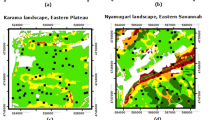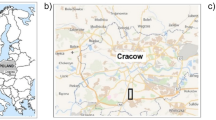Abstract
The influence of three spatially hierarchical factors upon soil macrofauna biodiversity was studied in four pasture plots in eastern Amazonia. The first factor was the local depth of the soil. The second factor was the ground cover type on the soil samples (bare ground, grass tufts, dead trees lying on the ground). The third factor was the dimensions of the grass tufts sampled (size and shape). The effect of each factor upon the morphospecies richness and density of total soil macrofauna was analysed. Detailed results are given for earthworms, termites, ants, beetles and spiders. All factors significantly affected the morphospecies richness and/or density of the soil macrofauna. The type of ground cover had the strongest influence, affecting the total richness and density of the soil macrofauna and of almost all the groups represented. The soil depth affected only the density of the termites and the global morphospecies richness. Interactions between soil depth and ground cover type affected the total macrofauna morphospecies richness and the density of the earthworms. The dimensions of the grass tuft influenced the global morphospecies richness, the morphospecies richness of the ants and the density of the spiders.





Similar content being viewed by others
References
Allen TFH, Starr TB (1982) Hierarchy: perspectives for ecological complexity, 1st edn. University of Chicago Press, Chicago, Ill.
Anderson JM, Ingram JSI (1993) Tropical soil biology and fertility. A handbook of methods, 1st edn. CAB International, Wallingford
Barros E, Curmi P, Hallaire V, Chauvel A, Lavelle P (2001) The role of macrofauna in the transformation and reversibility of soil structure of an oxisol in the process of forest to pasture conversion. Geoderma 100:193–213
Barros E, Pashani B, Constantino R, Lavelle P (2002) Effects of land-use system on the soil macrofauna in western Brazilian Amazonia. Biol Fertil Soils 35:338–347
Barros E, Neves A, Blanchart E, Fernandes ECM, Wandelli E, Lavelle P (2003) Development of the soil macrofauna community under silvopastoral and agrosilvicultural systems in Amazonia. Pedobiologia 47:273–280
Bierregard RO, Gascon C, Lovejoy TE, Mesquita RCG (2001) Lessons from Amazonia. The ecology and conservation of a fragmented forest. Yale University Press, New Haven, Conn.
de Bruyn LA, Conacher AJ (1990) The role of termites and ants in soil modification: a review. Aust J Soil Res 28:55–93
Buechner M (1987) Conservation in insular parks: simulation of factors affecting the movements of animal across park boundaries. Biol Conserv 41:57–76
Cole BJ (1983) Assembly of mangrove ant communities: colonization abilities. J Anim Ecol 52:349–355
Costa FP, Rehman T (1999) Exploring the link between farmer’s objectives and the phenomenon of pasture degradation in the beef production systems of Central Brazil. Agric Syst 61:135–146
Curry JP (1987) The invertebrate fauna of grassland and its influence on productivity. III. Effects on soil fertility and plant growth. Grass Forage Sci 42:325–341
Decaëns T, Lavelle P, Jiménez JJ, Escobar G, Rippenstein G (1994) Impact of land management on soil macrofauna in the Oriental Llanos of Colombia. Eur J Soil Biol 30:157–168
Decaëns T, Mariani L, Lavelle P (1999) Soil surface macrofauna communities associated with earthworm casts of the Eastern Plains of Colombia. Appl Soil Ecol 13:87–100
Edwards CA, Bohlen PJ (1996) Biology and ecology of earthworms, 3rd edn. Chapman and Hall, London
Ekschmitt K, Griffiths BS (1998) Soil biodiversity and its implications for ecosystem functioning in a heterogeneous and variable environment. Appl Soil Ecol 10:201–215
Ettershank G, Ettershank JA, Withford WG (1980) Location of sources by subterranean termites. Environ Entomol 9:645–648
Forman RTT, Godron M (1986) Landscape ecology, 1st edn. Wiley, New York
Fragoso C, Brown GG, Patron JC, Blanchart E, Lavelle P, Pashanasi B, Senapati B, Klumar T (1997) Agricultural intensification, soil biodiversity and agroecosystem function in the tropics: the role of earthworms. Appl Soil Ecol 6:17–35
Giles RH Jr, Trani MK (1999) Key elements of landscape pattern measures. Environ Manage 23:477–481
Goldsbrough CL, Hochuli DF, Shine R (2003) Invertebrate biodiversity under hot rocks: habitat use by the fauna of sandstone outcrops in the Sydney region. Biol Conserv 109:85–93
Hamazaki T (1996) Effects of patch shape on the number of organisms. Landsc Ecol 11:299–306
Hölldobler B, Wilson EO (1990) The ants, 1st edn. Harvard University Press, Cambridge, Mass.
ISSS Working Group R.B. (1998) World reference base for soil resources: introduction. In: Deckers JA, Nachtergaele FO, Spaargaren OC (eds) International Society of Soil Science (ISSS), 1st edn. ISRIC, FAO, ISSS, Leuven
Jolimakï J, Huhta E, Itämies J, Rahko P (1998) Distribution of arthropods in relation to forest patch size, edge, and stand characteristics. Can J For Res 28:1068–1072
Kotliar NB, Wiens JA (1990) Multiple scales of patchiness and patch structure: a hierarchical framework for the study of heterogeneity. Oikos 59:253–260
Lavelle P, Pashanasi B (1989) Soil macrofauna and land management in Peruvian Amazonia (Yurimaguas, Loreto). Pedobiologia 22:283–291
Lavelle P, Spain AV (2001) Soil ecology, 1st edn. Kluwer, Amsterdam
Lavelle P, Bignell D, Lepage M, Wolters V, Roger P, Ineson P, Heal OW, Dhillion S (1997) Soil function in a changing world: the role of invertebrate ecosystem engineers. Eur J Soil Biol 33:159–193
Levin SA (1992) The problem of pattern and scale in ecology. Ecology 73:1943–1967
Mrzljak J, Wiegleb G (2000) Spider colonization of former brown coal mining areas-time or structure dependent? Landsc Urban Plan 51:131–146
Muchagata M, Brown K (2003) Cows, colonists and trees: rethinking cattle and environmental degradation in Brazilian Amazonia. Agric Syst 76:797–816
Radford BJ, Wilson-Rummenie AC, Simpson GB, Bell KL, Fergusson MA (2001) Compacted soil affects soil macrofauna populations in a semi-arid environment in central Queensland. Soil Biol Biochem 33:1869–1872
Sabatier D, Grimaldi M, Prévost M-F, Guillaume J, Godron M, Dosso M, Curmi P (1997) The influence of soil cover organisation on the floristic and structural heterogeneity of a Guianan rain forest. Plant Ecol 131:81–108
Smith JL, Rust MK (1994) Temperature preference of the western subterranean termite, Reticulitermes hesperus Banks. J Arid Environ 28:313–323
Sokal RR, Rohlf FJ (1995) Biometry: the principles and practice of statistics in biological research, 3rd edn. Freeman, New York
Webster R (2001) Statistics to support soil research and their presentation. Eur J Soil Sci 52:331–340
Wiens JA (1989) Spatial scaling in ecology. Funct Ecol 3:385–397
Winer BJ (1971) Statistical principles in experimental design, 1st edn. McGraw-Hill, New York
Wolters V (2001) Biodiversity of soil animals and its function. Eur J Soil Biol 37:221–227
Acknowledgements
We should like to thank LASAT for field access facilities and CNPq. for its interest in our work. We are very grateful for the help in identification provided by Marlucia Martins (Museum Paraense Emilio Goeldi, Belem), Jacques Delabie (Laboratorio de Mirmecologia CEPEC/CEPLAC, Itabuna), Amazonas Chagas Jr (Museu Nacional, Universidade Federal do Rio de Janeiro) and Maria Lucia Jardim Macambira (Museum Paraense Emilio Goeldi, Belem).
Author information
Authors and Affiliations
Corresponding author
Rights and permissions
About this article
Cite this article
Mathieu, J., Rossi, JP., Grimaldi, M. et al. A multi-scale study of soil macrofauna biodiversity in Amazonian pastures. Biol Fertil Soils 40, 300–305 (2004). https://doi.org/10.1007/s00374-004-0777-8
Received:
Revised:
Accepted:
Published:
Issue Date:
DOI: https://doi.org/10.1007/s00374-004-0777-8




